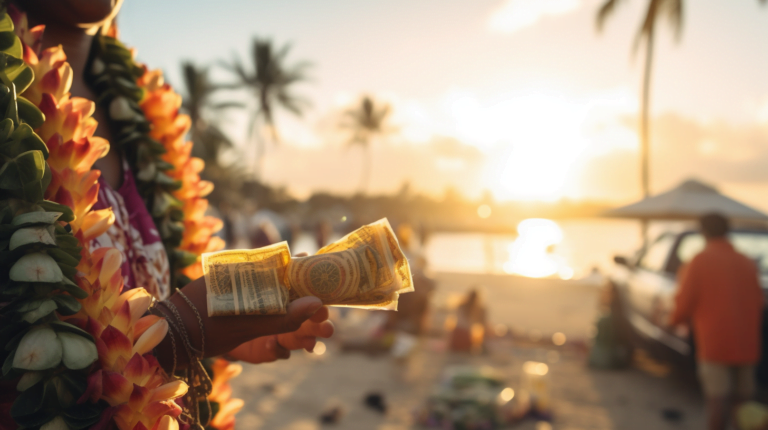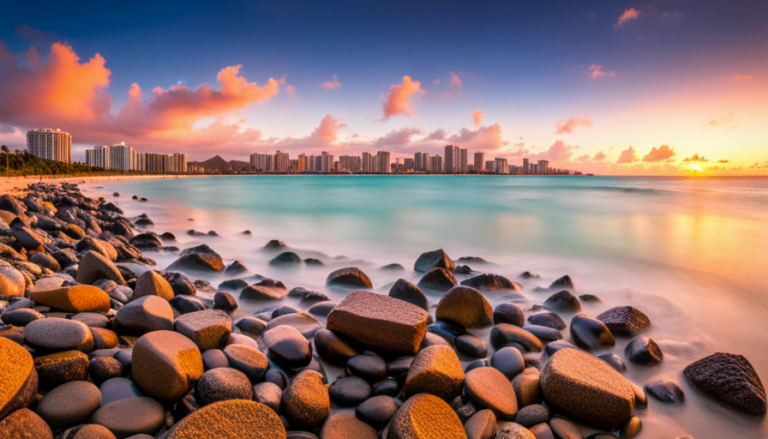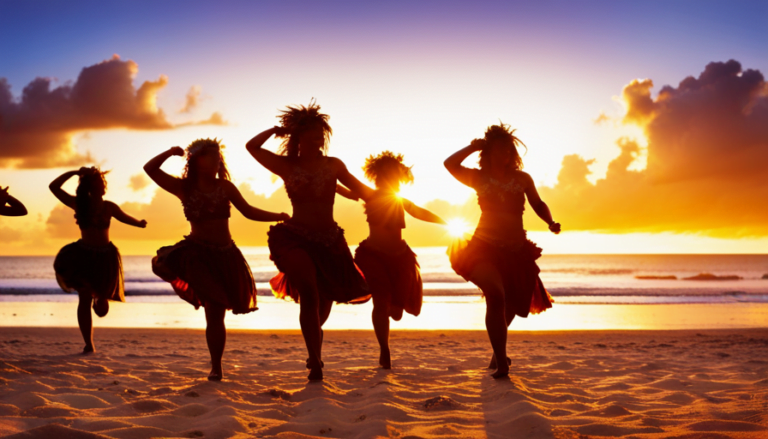Discover Oahu: Essential Laws and Etiquette for Visitors 🌴
As a visitor to Oahu, it is important to familiarize yourself with the various laws and regulations in place to ensure a safe and enjoyable experience on the island. From beach rules to traffic laws, Oahu has a set of guidelines that must be followed by all visitors. It is crucial to understand the laws and regulations to avoid any legal issues or conflicts during your stay on the island.
One of the most important regulations to be aware of is beach rules. Oahu has a set of rules and regulations in place to protect the environment, ensure public safety, and promote responsible behavior. These rules include no smoking on the beach, no alcohol consumption on the beach, and no littering.
It is also important to know the ocean conditions and to only swim in areas that are deemed safe by the lifeguards. By following these rules, you can enjoy the beautiful beaches of Oahu without putting yourself or others in danger.
Key Takeaways
- Visitors must abide by strict laws and regulations regarding beach rules, traffic laws, rental car regulations, alcohol and drug laws, and cultural respect and etiquette.
- Wildlife and conservation laws must be followed to protect the flora and fauna of the island.
- Emergency services and medical facilities are available on Oahu, and health insurance is highly recommended before traveling.
- Tourist assistance centers are available to provide necessary support and information for visitors, including knowledge about local laws and regulations.
Beach Rules and Regulations
Just like a lifeguard keeping a watchful eye on the ocean, visitors to Oahu’s beaches must follow certain rules and regulations to ensure everyone’s safety and enjoyment. Beach safety is a top priority on the island, and visitors must adhere to rules such as no diving or jumping off rock formations and no swimming outside of designated areas. These rules are in place to prevent accidents and keep everyone safe.
It’s also important to pay attention to beach closures, as they may occur due to weather conditions or other safety concerns. Visitors should always check with lifeguards or local authorities before entering the water.
In addition to beach safety, visitors must also be aware of parking and littering regulations. Parking is often limited, so it’s important to follow designated parking areas and not block emergency access roads. Littering on the beach is also strictly prohibited, and visitors should dispose of trash in designated receptacles to keep the beaches clean and beautiful.
By following these rules and regulations, visitors can enjoy their time on Oahu’s beaches while also ensuring the safety and preservation of the environment.
Now let’s move on to the next topic of traffic laws.
Traffic Laws
You’ll want to pay attention to the speed limits on Oahu’s roads, especially in residential areas where they drop significantly. Traffic safety is a top priority on the island, and the authorities enforce strict regulations to ensure that visitors and locals alike are safe on the roads.
Here are some important things to keep in mind:
- Oahu’s traffic can be heavy and congested, especially during peak hours.
- Pedestrians have the right of way at marked crosswalks, and drivers must yield to them.
- It’s illegal to use a handheld cell phone while driving on Oahu.
- Rental car regulations require all drivers to be at least 21 years old and have a valid driver’s license.
- Always wear your seatbelt and make sure that children are properly secured in car seats.
It’s important to be aware of these regulations to ensure that you have a safe and enjoyable time on Oahu. As you navigate the island’s roads, keep in mind that alcohol and drug laws are also strictly enforced.
Alcohol and Drug Laws
When visiting Oahu, it’s important to familiarize yourself with the alcohol and drug laws. The legal drinking age is 21 years old. It’s prohibited to possess or consume illegal substances such as marijuana and cocaine. Public intoxication is also against the law and may result in fines or imprisonment.
Be sure to follow these laws to avoid any legal issues during your visit to Oahu.
Legal Drinking Age
If you’re feeling down about not being able to legally drink until you’re 21, don’t worry, there are still plenty of ways to have a blast on Oahu! It’s important to note that Hawaii has strict enforcement policies when it comes to underage drinking, so it’s best to wait until you’re of legal age to avoid any legal trouble. Additionally, cultural attitudes in Hawaii promote responsible drinking and respect for the community, so it’s important to be mindful of your behavior when consuming alcohol.
To give you a better idea of the legal drinking age in Hawaii compared to other states, take a look at this table:
| State | Legal Drinking Age |
|---|---|
| Hawaii | 21 |
| California | 21 |
| Nevada | 21 |
| New York | 21 |
As you can see, the legal drinking age in Hawaii is the same as many other states in the US. However, it’s important to remember that laws and regulations can vary from state to state, so it’s always a good idea to do your research beforehand. Moving forward, let’s take a closer look at the laws and regulations surrounding prohibited substances on Oahu.
Prohibited Substances
It’s important to be aware of the prohibited substances in Hawaii to ensure a safe and enjoyable trip. While Hawaii legalized medical marijuana in 2000, it’s still illegal to smoke it in public. This means that visitors with medical marijuana prescriptions should consume it in private areas like their hotel rooms or designated smoking areas.
Additionally, it’s important to note that recreational marijuana is still illegal in Hawaii, and possession or use of it can result in serious legal consequences.
Furthermore, smoking restrictions are in place to protect the health of both visitors and locals. Smoking is prohibited in all public areas, including beaches, parks, and sidewalks. Violators can face a fine of up to $50 for their first offense, and up to $500 for subsequent offenses.
To avoid any legal trouble, it’s recommended that visitors refrain from smoking in public areas and instead seek out designated smoking areas or private spaces.
When it comes to public intoxication, Hawaii has strict laws in place to deter visitors from engaging in disruptive or dangerous behavior.
Public Intoxication
Moving on from prohibited substances, it is important to understand the laws and regulations regarding public intoxication on Oahu as a visitor. Public intoxication is not tolerated in the state of Hawaii and can result in severe consequences. It is important to be aware of the laws and regulations to ensure a safe and enjoyable experience on the island.
The consequences of public intoxication on Oahu can include fines, arrest, and even deportation. The enforcement of public intoxication laws is taken seriously by the Honolulu Police Department, and officers have the authority to arrest individuals who are visibly intoxicated in public places. It is important to remember that as a visitor, you are subject to the same laws and regulations as locals and can face the same consequences for breaking them. Therefore, it is important to be responsible and aware of your alcohol consumption while in public places on the island.
Moving forward, it is important to also be mindful of cultural respect and etiquette while visiting Oahu.
Cultural Respect and Etiquette
When visiting Hawaii, it’s important to show respect for the local culture and customs.
This includes understanding and appreciating the significance of the Hawaiian language and culture, as well as showing respect for sacred sites such as heiaus and burial grounds.
Additionally, there’s a dress code to consider when visiting certain areas or events, so it’s important to be mindful of appropriate attire.
Overall, demonstrating cultural respect and etiquette is essential for a positive and meaningful experience in Hawaii.
Hawaiian Language and Culture
Visitors to Oahu should make sure to respect the Hawaiian language and culture by learning some basic phrases and understanding the significance of traditional practices like hula and lei-making. Hawaiian language revitalization efforts have been ongoing for several decades, and visitors can contribute to this effort by taking the time to learn some basic words and phrases. Cultural workshops are also available throughout Oahu, providing opportunities for visitors to learn about traditional practices like hula and lei-making from local artists and practitioners.
To further show respect for the Hawaiian culture, visitors should also be mindful of their behavior and actions. For instance, it is considered disrespectful to step on or touch sacred sites like heiaus (ancient Hawaiian temples) or burial grounds without the appropriate permission or guidance from a cultural practitioner. By being mindful of these practices and taking the time to learn about the culture, visitors can contribute to the preservation of Hawaiian traditions and show their appreciation for the unique beauty of Oahu.
Respect for Sacred Sites
It’s important to show cultural sensitivity and respect for sacred sites when visiting Hawaii. As a visitor, it’s crucial to seek guidance from cultural practitioners and to be mindful of our actions when visiting these sites.
Here are three things to keep in mind when visiting sacred sites on Oahu:
- Historical Preservation – Many sacred sites on Oahu have significant cultural and historical importance to the people of Hawaii. It’s crucial to respect the sites by not touching or removing any artifacts or rocks, and by not altering the landscape or vegetation surrounding the site.
- Cultural Sensitivity – Visitors should be aware that many of these sacred sites are still used for religious and cultural practices by the Hawaiian people. It’s important to be respectful of these practices and to not disturb any ceremonies or rituals that may be taking place.
- Educational Opportunities – Visiting sacred sites in Hawaii can also provide an opportunity to learn about the rich history and culture of the Hawaiian people. Visitors should take advantage of the educational resources available, such as guided tours or informational plaques, to gain a better understanding of the significance of these sites.
In addition to showing reverence for sacred sites, it’s also important to be mindful of the dress code when visiting certain locations in Hawaii.
Dress Code
Proper attire is crucial for showing respect to the culture and customs of Hawaii while visiting sacred sites. As a visitor, it’s important to be mindful of the significance of these sites to the local community and to dress appropriately. This means avoiding revealing clothing such as shorts, tank tops, and swimsuits. Instead, opt for clothing that covers your shoulders and knees, such as a lightweight long-sleeved shirt and pants.
Cultural sensitivity is key when it comes to dress code in Hawaii. By dressing appropriately, you’re not only showing respect for the sacred sites but also for the local culture and customs. It’s important to remember that Hawaii is a place of great cultural diversity, and by dressing appropriately, you’re honoring and embracing that diversity.
With this in mind, let’s move on to the next topic of wildlife and conservation laws.
Wildlife and Conservation Laws
Take time to learn about the wildlife and conservation laws in place on Oahu to protect the precious flora and fauna. As a visitor, it’s important to be aware of these regulations to ensure that you don’t unknowingly harm the natural environment.
Here are four key points to keep in mind:
- Don’t disturb or remove any wildlife, including marine life. This includes sea turtles, monk seals, and other endangered species that call Oahu home. It’s illegal to touch, feed, or harass these animals, and doing so can result in hefty fines.
- Stay on designated trails when hiking or exploring natural areas. The delicate ecosystem of Oahu can be easily disrupted by foot traffic, so it’s important to stick to established paths to minimize your impact on the environment.
- Don’t litter or leave any trash behind. Properly dispose of any garbage or waste materials in designated bins or take them with you when leaving a natural area.
- Support conservation efforts by visiting places that prioritize animal welfare and sustainable practices. Look for eco-friendly tours and activities that minimize their impact on the environment and support local conservation efforts.
By following these regulations, you can help protect the natural beauty of Oahu for future generations to enjoy. With that in mind, it’s also important to be aware of emergency services and contact information in case of any accidents or unexpected situations during your visit.
Emergency Services and Contact Information
When you’re visiting Oahu, it’s crucial to know the emergency services and contact information available in case of any unforeseen circumstances.
The police and fire department are readily available to assist you in emergencies, such as accidents, theft, or any criminal activities.
If you require medical assistance, you can contact any of the medical services available on the island.
Additionally, there are tourist assistance centers to provide you with any necessary information and support during your stay.
Police and Fire Department
You’ll be glad to know that if you ever need assistance from the Police or Fire Department while on Oahu, they’re both highly trained and equipped to handle any emergency.
The Honolulu Police Department is one of the largest police departments in the United States, with over 2,000 sworn officers responsible for maintaining the safety and security of the island. They receive extensive training in areas such as crisis intervention, cultural sensitivity, and community policing to ensure that they can effectively serve the diverse population of Oahu.
The Honolulu Fire Department provides a wide range of services, including fire suppression, emergency medical services, and hazardous materials response. They also offer community outreach programs, such as fire prevention education and CPR training. With over 1,000 firefighters spread across 43 stations on Oahu, they’re able to respond quickly to any emergency.
It’s reassuring to know that both the Police and Fire Departments are available to provide assistance in case of an emergency. Moving on to medical services…
Medical Services
Moving on from the previous subtopic, it is important to know about the medical services available on Oahu. In case of any medical emergency, you can dial 911 for immediate assistance. Oahu has several medical facilities that offer quality healthcare services to visitors. However, it is important to note that medical services in the United States can be quite expensive, and it is highly recommended that you have health insurance before traveling to Oahu.
To help you plan ahead, here is a table of some of the medical facilities available on Oahu:
| Medical Facility | Address | Contact Number |
|---|---|---|
| The Queen’s Medical Center | 1301 Punchbowl St, Honolulu, HI 96813 | (808) 691-1000 |
| Straub Clinic and Hospital | 888 S King St, Honolulu, HI 96813 | (808) 522-4000 |
| Pali Momi Medical Center | 98-1079 Moanalua Rd, Aiea, HI 96701 | (808) 486-6000 |
It is important to note that this is not an exhaustive list, and there are several other medical facilities available on the island. It is always a good idea to research and locate the medical facilities closest to your accommodation. In case of any medical emergency, do not hesitate to call 911 for immediate assistance.
Moving forward, if you require any assistance during your stay on Oahu, there are several tourist assistance centers available on the island.
Tourist Assistance Centers
If you need help during your trip, there are tourist assistance centers available on the island that can provide you with the necessary support. These centers can help you with any tourist information you may need, such as maps, brochures, and recommendations for places to visit. They can also assist you in booking tours or activities, and provide you with transportation options.
If you’re concerned about a language barrier, don’t worry. These information centers usually have multilingual staff who can speak various languages such as English, Japanese, Korean, and Mandarin, to name a few. They’re also knowledgeable about local laws and regulations, so if you have any questions or concerns, don’t hesitate to ask.
The tourist assistance centers are there to help you have a safe and enjoyable trip while visiting Oahu.
Frequently Asked Questions
Are there any restrictions on using drones or other flying devices on the beaches of Oahu?
You cannot fly drones or other flying devices on Oahu’s beaches due to airspace restrictions and drone regulations. It is important to respect these rules and ensure that you do not endanger others.
Can visitors bring their own alcohol to the beach, or are there restrictions on drinking in public areas?
You are not allowed to bring your own alcohol to public beaches on Oahu. There are enforcement of drinking laws in place. Additionally, bringing food and pets to the beach is permitted, but be sure to clean up after them.
What are the rules regarding smoking on the beaches of Oahu?
As you stroll along the sandy shores of Oahu, remember that smoking is strictly prohibited on the beaches. Respect beach etiquette and refrain from lighting up to ensure a safe and enjoyable experience for all.
Are there any specific dress codes or clothing restrictions that visitors should be aware of when visiting cultural or religious sites on the island?
When visiting cultural or religious sites on Oahu, be aware of respectful behavior expectations and cultural attire guidelines. Dress modestly and remove shoes before entering temples or shrines.
Are there any limitations on hiking or exploring certain areas of Oahu’s natural reserves or conservation areas?
When hiking in Oahu’s natural reserves, be aware of any posted signs indicating trail closures or restrictions. Certain areas may be off-limits due to conservation efforts or safety concerns. Always stay on designated trails to protect the fragile ecosystem.







